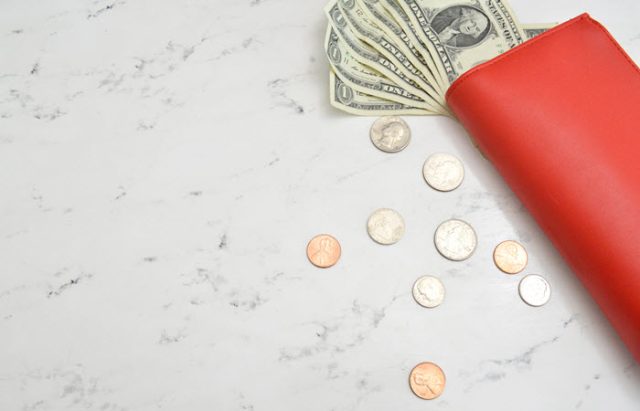Saving Half of Income: 5 Steps to Effortlessly Save Money Every Month
By Mohammed Bello
December 30, 2019 • Fact checked by Dumb Little Man

“Payment Successful”
That’s it. Gone forever.
Your last $50 spent in grocery bills and you think “Where does all my money go?” .
You wonder how your co-workers can afford all the glitter and gold while you end up without a dime to pay for the piling bills.
In fact, you always have this nagging feeling that you’ll end up spending your next paycheck with nothing to show for it.
And you can’t help but think:
Is it normal to feel like I’ll lose all my money even if I won the lottery? Will I always be dead broke or pretty much close?
Deep down, you know you are NOT on the right track.
Things must change.
Step 1 – Commit to mastery
Five thousand four hundred and seventy five…
The days it took for ancient Chinese monks to master the art of Kung-Fu. Guess what they were doing for all those hours?
Practicing Kung-Fu.
But more importantly, they vowed to dedicate not only those hours, but their entire lives to the Art.
The Monk’s Guide to Saving
You’re probably wondering what Martial Arts have to do with your money. Well, here’s the big secret:
Although learning to save doesn’t require hours of vigorous training, like Kung Fu, it does require a fair deal of practice and discipline.
Why?
Because more than an ingrained habit, savings must be a mastered skill. Granted, that takes sustained effort, restraint, patience, and time.
Once you make an unwavering commitment to set aside a specific amount every month, you are well on your way to quadrupling your savings in no time.
So, adjust your mindset and commit to practicing all the steps.
WARNING:
Most people take this step for granted and make a fickle decision to sparingly set aside “some money, somehow”.
And guess what?
They end up with zero in savings and bitter with life.
Obviously, that’s a recipe for disaster and you want to avoid it at all costs. It will sour your taste buds and empty your pockets, literally.
Step 2 – Record all income

Quick Question:…
Do you know exactly what you earned last month?
I mean with 99.99% precision.
Cracking your brain yet?
When planning to save, it is not uncommon for people to become absorbed in monitoring their expenses while completely ignoring the essential piece. It’s tracking their income every day.
Determining the exact amount you receive in daily earnings is a crucial step that provides the basis for the following:
- Means to identify your primary and secondary sources of income
- Scale to measure an increase or a decrease in your earnings
- Guide to track all of your expenses
- Road-map to monitor your progress towards savings
- A Reference point for making informed future investment decisions
See how this gold mine of useful information can improve your overall financial well-being?
The ridiculously easy way to keep track of your income
Tracking anything isn’t easy, especially your income. You have no idea what those cryptic bank statements mean and you have no clue what ledgers are. You have zero interest in the term “deductibles”.
Not to worry, you don’t need to know all those boring accounting jargon.
In fact, all you need is to record every dollar bill you earn every day and translate that to your weekly and overall monthly earnings.
Here is a simple sheet to illustrate the concept a little better:
Source : Hours – Pay Per Hour – Daily – Weekly – Monthly
Salary : 8 – $10 – $80 – $ – $
Business : $100 – $100 – $ – $
Other – – – – –
Total: $180 – $ – $
Date: Today
Don’t worry, you can adapt it to your particular situation.
Why the slightest changes to your money matter
The total of your monthly earnings is like a mini-map that guides you to your saving goal by informing you about your current position, destination, and journey.
Hence, tracking the slightest changes in your daily income with precision is key to ensuring your mini-map is accurate. Use the format above for guidance. Copy it into a jotter and practice every day for the next month.
Note: You would prefer to write your earnings with pen on paper because it excites your senses and provides you with a handy reference point.
Step 3 – Spend it all
Pour all your money down the drain!
Yep, you heard me right. Spend every penny you make, but do it the right way.
Before you think I am a financial Frankenstein speaking in tongues and desperate to make you my lab rat, allow me to explain.
Every day, for the next 30 days, you’ll be spending your recorded income as usual but with a little tweak.
How to tweak your spending for maximum results
You will take note of every little expense- like down to .99 cents.
Because again, you probably have no clue what your previous month’s expenses were. And to improve your saving habits, you’ll need to identify the areas you spend money the most and make adjustments.
A surprising lesson from billionaires
You would think that billionaire Warren Buffet owns a luxurious fleet of custom Rolls Royce Coupes delivered directly from the factory to his Garage every year.
Well, that isn’t the case.
He actually drives a $23,000 Cadillac DTS and he bought a used one.
Shocking?
Most mega-rich people like Jeff Bezos and Mark Zuckerberg understand and apply a timeless and effective financial secret.
The simple saving technique that never fails is that they live below their means by prioritizing needs over wants.
In other words, whatever isn’t a necessity is eliminated. And you’ll be applying the same principle to fast track the process of saving half of your income or even more every month.
Take note of your spending every single day, preferably for the next 30 days.
Within a month, you would have recorded your earnings, drilled down on your spending habits, and produced a clear (most times shocking) picture of where you are throwing away money.
Only then will you be in a better position to prioritize your needs and eliminate your wants.
Step 4 – Hone your skills

At this point, you’d be halfway towards saving half of income and ready to hone your newly acquired saving skills by applying some effective tips.
Ready?
To proceed further down the rabbit hole, it is crucial to learn this lesson:
Set a savings and spending goal for the next month.
Example:
- January savings goal: 50% of monthly income
- January spending goal: 50% of monthly income
If the expense tracking exercise reveals that you are capable of living on 50% of your income (or less), then increase your savings by using the tips below. If, not, then use the following tips to lower your monthly spending.
10 Ideas for Saving Effectively
- Stay organized by dividing cash into envelopes with categories like “food”, “rent”, and “transport”. When an envelope runs empty, stop spending in that category.
- Reduce the discreet flow of energy (Phantom Power) by unplugging cell phone chargers, TVs, and computers when you’re not using them.
- Walk, bike, use the subway, ride the tram, bus or commute to easily save more than $100 per month on gas.
- Leave your wallet when you head out so you won’t be tempted to grab coffee or go on a mini shopping trip.
- Save at least $500 a year by canceling cable TV and switching to alternatives like Netflix which costs $8 per month.
- Buy items in bulk to save money on unit price.
- Sleep, exercise, and eat healthy to prevent incurring expensive medical bills.
- Reduce impulse purchases by sticking to a shopping list when going to the grocery store.
- Save spare change in a piggy bank.
- Eat in, not out.
Note: You can add more to these tips. Be creative. When reducing your monthly expenses, focus on every possible angle and don’t leave any stones unturned.
Step 5 – Test Run, Rinse, and Repeat
The rubber meets the road here…
Time to test your new set of acquired skills. Use this effective testing template:
- Month 1: Apply steps 1 to 3 every day
- Month 2: Apply steps 2 – 5 every day
What happens after Month 2?
Tweak your progress and repeat. From the second month onward, two things can happen.
It’s either you fail to act and end up back in square one or you commit to applying all steps and save half of your income or more.
Final Thoughts
Being broke sucks, particularly when you know you are throwing money away.
But simple changes to the way you spend can have dramatic effects on your saving habits. Just imagine ending up with every dollar saved at the end of the month.
Imagine waking up every day with absolute financial freedom that comes from being penny-wise. Think about being able to afford that nice Mercedes or that chateau in Cannes or perhaps, that comfy corner couch you have been interested in for a while now.
Remember, success is the gradual realization of a worthy ideal.
To begin your successful journey, apply the first and second techniques above, starting now. Commit to practicing the rest of the process every day, for the next few weeks. Keep track, make changes, and improve as you go along.
You could be saving half of income or more next month.
See Also: HSA or FSA: Which One Do You Really Need To Maximize Your Savings?
Mohammed Bello
Mohammed Bello is a passionate a passionate freelance writer who loves writing valuable posts that resonate with people. Connect with him on LinkedIn to see how he can serve you.







